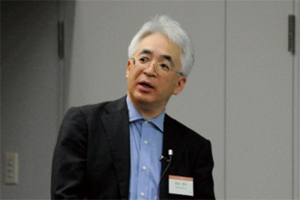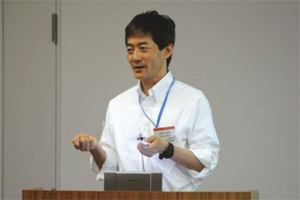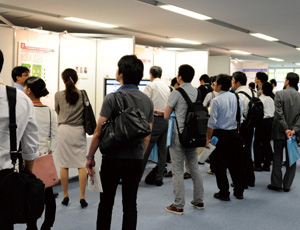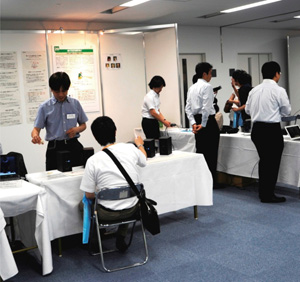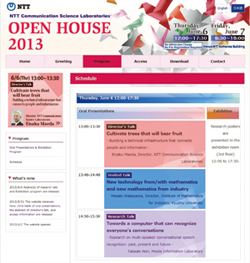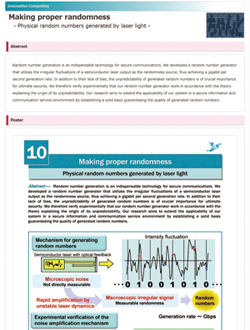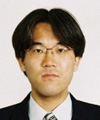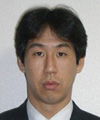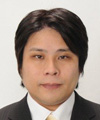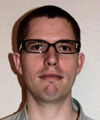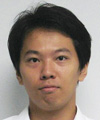 |
|||||
|
|
|||||
|
Information Vol. 11, No. 12, pp. 50–55, Dec. 2013. https://doi.org/10.53829/ntr201312in1 Report on NTT Communication Science Laboratories Open House 2013AbstractOpen House 2013 was held in June at NTT Communication Science Laboratories in Keihanna Science City, Kyoto. Over 1000 people visited the facility on June 6 and 7 to enjoy 6 talks and 30 exhibits introducing our latest research activities and efforts in the fields of information and human sciences. This article reports on the main activities conducted during the open house. Keywords: information science, human science, big data analysis 1. IntroductionAt NTT Communication Science Laboratories (NTT CS Labs), we aim to build a new technical infrastructure connecting people and information and are therefore studying aspects of both human and information sciences to create innovative technologies and discover new principles. Branches of NTT CS Labs are located in Kansai Science City (Seika-cho, Kyoto) and Atsugi City, Kanagawa. These laboratories deal with the most fundamental research targets in the fields of human and information sciences in the NTT laboratories. The open house of NTT CS Labs has been held annually with the aim of introducing the results of the Labs’ basic research and innovative leading-edge research to both NTT Group employees and visitors from corporations, universities, and research institutions who are engaged in research, development, business, and education. This year, the event was held at the NTT Keihanna Building in Kansai in the afternoon of June 6 and all day on June 7, 2013. A total of 1140 visitors attended the event over the two days. Through talks and exhibits, we introduced our latest research results and explained how they were expected to affect future technologies and academic progress. In the special category of big data analysis, we presented exhibits organized by NTT CS Labs and other NTT laboratories. This article summarizes the event’s research talks and exhibits. 2. Keynote speechThe open house started with a speech by the Director of NTT CS Labs, Dr. Eisaku Maeda, entitled “Cultivate trees that will bear fruit—Building a technical infrastructure that connects people and information—” (Photo 1).
Since the start of the 21st century, both the volume and nature of the information that people have to deal with have changed greatly. Examples include ubiquitous information as well as that from sensor networks, cloud computing, and big data. The devices used for accessing communication networks have also largely shifted from desktop computers and cell phones to tablets and smartphones. Dr. Maeda talked about the research policy whereby, in the midst of these dramatic changes in the information environment, NTT CS Labs would study both mathematical principles and actual data to build a new technical infrastructure connecting people and information. He then introduced reverberation control, robust media search, question answering, and information science on material perception as successful research results produced by NTT CS Labs and applied in today’s society. He mentioned that the initial research themes led us to new services and discoveries not even imagined when work started on the themes over a decade ago, and he emphasized that it was very important to cultivate research themes over such long periods of time. 3. Research talksFour of the talks highlighted recent notable research results and high-profile research themes: - “Towards a computer that can recognize everyone’s conversations—Research on multi-speaker conversational speech recognition: past, present and future—”, Dr. Takaaki Hori, Media Information Laboratory - “The reality of the body—How we perceive our own body—”, Dr. Norimichi Kitagawa, Human and Information Science Laboratory - “Innovative user experiences brought by statistical machine translation—Breaking the language barriers of technical information”, Dr. Masaaki Nagata, Innovative Communication Laboratory - “Extracting hidden information from speech and audio signals—Generative modeling approach to speech and audio signal processing—”, Dr. Hirokazu Kameoka, Media Information Laboratory Each presentation introduced some of the latest research results and provided some background and an overview of the research. All of the talks were very well received. Dr. Hori introduced the technology developed at NTT CS Labs for automatically recognizing conversational speech in meeting situations, and he discussed current problems related to conversational speech recognition and the future developments we can expect as more progress is made in this technology (Photo 2). Dr. Nagata’s talk on innovative user experiences achieved through statistical machine translation focused on NTT CS Labs’ latest research results on statistical machine translation and its automatic evaluation, in particular, between English and Japanese, which is one of the most difficult-to-translate language pairs in the world (Photo 3).
4. Research exhibitsThe open house featured 23 exhibits displaying NTT CS Labs’ latest research results, and these were classified into the categories innovative computing, media and communication, and human science. The open house also included a special big data analysis category that consisted of two exhibits from NTT CS Labs and four from other NTT laboratories (Photo 4). The special category also included an exhibit summarizing the research directions that NTT laboratories were focusing on and the real-world problems being tackled in the fields of machine learning and data science.
Each exhibit was housed in a booth and was presented using slides on a large-screen monitor or hands-on demonstrations, with researchers explaining the latest results directly to visitors. The following list summarizes the research exhibits. Big data analysis- Challenges with big data—Recent big data analysis at NTT laboratories— - Understanding stream data from essential elements—Feature selection for high-dimensional time series data— - Smarter instant analysis of “Current” with big data—Streaming analysis with distributed online machine learning— - Efficient graph mining techniques for big data—Fast algorithms for large-scale graphs— - Network anomaly detection using big data analysis—Analyzing network failure/cyber attacks and their root causes— - What is the author like? —Estimation of microblog user attributes using microblog structure— - Massive trajectory data analysis and visualization—Mobility pattern analysis using heterogeneous data— Innovative computing- Efficient environmental monitoring—Correlated data gathering for sensor network— - Exposing your whereabouts safely—Location privacy by using pseudonym exchange— - Quantum information exchange employing optics—Optimal entanglement generation protocol with laser light— - Making proper randomness—Physical random numbers generated by laser light— - A visual language for advanced programming—Viscuit with new functions for advanced programming— - Automatic grammatical analysis of English—Syntactic parsing based on statistical grammar induction— Media and communication- How can we overcome language barriers? —Statistical machine translation from foreign languages to Japanese— - Yu bi Yomu: Reading experience based on trailing—A new method for reading dynamic texts using finger movements— - Ways to support non-native speakers in a conference call—How transmission lags influence multilingual communication— - Seeing into the mind in the twinkle of a smile—Analyzing expression/perception of interlocutors’ empathy— - Speech separation with collaborative recorders—Probabilistic fusion of different recording devices— - Transcribing every word whoever speaks—Speech recognizers robust to casual speech variations— - Transcribing known and unknown sounds—Bayesian semi-supervised audio event recognition— - Instance search from large video collections—Video search technology with visual examples— - Finding picture books suitable for a child—Graph-based similar picture book search with weighted child words— Human science- Mystery of child word learning order—Cross-linguistic universality of child word learning periods— - How children perceive phonemically similar words—Perceptual development of Japanese phonemes in children— - When breath meets music—Playback system synchronizing phrases with respiration phases— - Speak like a native—Speech rhythm control by non-negative temporal decomposition— - How we feel fatigue and force—Motor perception influenced by delayed visual feedback— - Future alters past—Postdictive processing in vision— - Visual magic: changing an object just by watching—Visual illusion reveals neural codes for objects in the brain— - Hearing the body—Action sounds recalibrate the perceived tactile distance— “Yu bi Yomu: Reading experience based on trailing” introduced and demonstrated a novel method for reading digital texts on computers with a touch panel (Photo 5). With this method, the text is barely visible on the computer monitor. When a reader traces his/her finger across the monitor, the characters in the location the finger touches gradually appear and then disappear. This dynamic text presentation based on finger movement can provide a richer impression while reading.
“Hearing the body” introduced a phenomenon whereby a simple auditory trick was able to induce an illusion that made a participant feel that his/her arm was elongated. This exhibit included some demonstrations that showed how people were able to sense their own body through somatosensation, vision, and hearing (Photo 6).
5. Invited TalkThis year’s event also featured an invited talk by Prof. Masato Wakayama, Director, Institute of Mathematics for Industry, Kyushu University, which was entitled “New technology from/with mathematics and new mathematics from industry” (Photo 7).
He first talked about the history of Japanese mathematics, including Takakazu Seki’s exploits in the Edo period, the progress of Japanese mathematics research after the Meiji period, when there was a full-scale introduction of western mathematics, and current problems resulting from the popularization of computers. Then, he described the relationship between mathematics and industrial technologies using the examples of cryptography, nanotechnology, and computer graphics. He suggested that mathematicians should discuss and share problems with industrial communities to improve both mathematics and industrial technologies. 6. Information transmission using the webWe have made continuous efforts to inform a large number of people about our research activities and results at NTT CS Labs. We set up both Japanese and English websites [1], [2] for Open House 2013 to improve the international dissemination of information (Fig. 1).
On the websites, we posted the open house program, venue, and access information, and put up abstracts of the research talks and exhibits in advance to enable visitors to obtain information about the event. After closing the event, the booklet, exhibition posters, and reference information were added to the websites (Fig. 2). Everyone can access this content. We will also upload videos of the director’s keynote speech and the four research talks.
7. Concluding remarksJust as they did last year, many visitors came to the NTT CS Labs Open House 2013 and engaged in lively discussions on the research talks and exhibits and provided many insightful opinions on the presented results. In closing, we would like to offer our sincere thanks to all of the visitors and participants who attended this event. References
|
|||||









